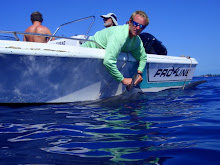
First I want to apologize for not keeping this updated as much as I'd hoped and I promise I will do much better these next two months. However, I hope the title grabbed your attention because we have done some pretty cool things this week.
Despite the strong winds (at least it's not snow)we have been able to do a variety of different projects to help the PI (principal investigator) with her project. One of the main focuses of her project is to determine how the destruction of the mangrove forest (construction of Bimini Bay) in the North Sound will effect the juvenile lemon sharks. Not only do the mangroves provide shelter for the sharks, but they also provide food. So thats right.....we wanted to see what was in their stomachs. We used a gill-net to capture several juvenile lemon sharks and then transferred them to a pen where we performed the procedures. The shark is put to sleep using an aesthetic called MS-222 and is then held upside down (my job) and using forceps the PI carefully pulled the sharks stomach lining out through the mouth and dumping the stomach contents into a tray. The stomach is carefully put back into the body cavity and the shark is revived (picture below). Unfortunately I was not able to get a picture of the procedure since I was holding the shark, but I will get one the next time we do it. The stomach contents reveal what the shark has eaten by matching the DNA found in the stomach contents to reference DNA samples from prey in the area.

In order to determine what prey is available for the sharks we use a very long net with small holes called a seine. The net has floats on the top and lead weight on the bottom. A seine team consists of at least 5 people: 2 people that pull the net and 3 that "scare" fish and other animals into the net. Once the net is stretched, the people pulling the net start a very tight circle and come towards one another as the "scarers" splash water and push the fish back towards the net. Once the two ends of the net come together everything is trapped inside and the net is then pulled tighter and tighter until all the contents are within a small circle. The top and the bottom of the nets are tightened together and then lifted onto a boat where it is a mad dash to sort the contents into buckets filled with water. All the fish inside are measured and weighed to get a sample of the prey availability in a given area. The majority of the fish we catch are small barracuda, needle fish, snappers, and a ton of small minnows called silversides. This week we caught a honeycomb cowfish (look it up it's awesome looking) and a DNA sample was taken to add to the reference collection. This then allows the researcher to determine what the sharks are eating compared to what is available to them. Hopefully these descriptions illustrated a good picture of what we have recently been doing at the lab.


No comments:
Post a Comment